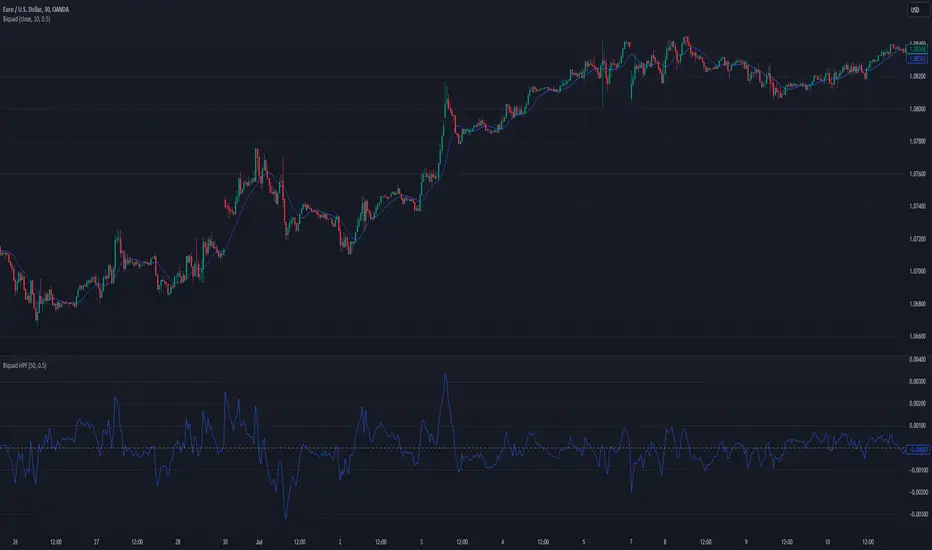OPEN-SOURCE SCRIPT
Updated Biquad High Pass Filter

This indicator utilizes a biquad high pass filter to filter out low-frequency components from price data, helping traders focus on high-frequency movements and detect rapid changes in trends.
The Length parameter determines the cutoff frequency of the filter, affecting how quickly the filter responds to changes in price. A shorter length allows the filter to react more quickly to high-frequency movements.
The Q Factor controls the sharpness of the filter. A higher Q value results in a more precise filtering effect by narrowing the frequency band. However, be cautious when setting the Q factor too high, as it can induce resonance, amplifying certain frequencies and potentially making the filter less effective by introducing unwanted noise.
Key Features of Biquad Filters
Biquad filters are a type of digital filter that provides a combination of low-pass, high-pass, band-pass, and notch filtering capabilities. In this implementation, the biquad filter is configured as a high pass filter, which allows high-frequency signals to pass while attenuating lower-frequency components. This is particularly useful in trading to highlight rapid price movements, making it easier to spot short-term trends and patterns.
Biquad filters are known for their smooth response and minimal phase distortion, making them ideal for technical analysis. The customizable length and Q factor allow for flexible adaptation to different trading strategies and market conditions. Designed for real-time charting, the biquad filter operates efficiently without significant lag, ensuring timely analysis.
By incorporating this biquad high pass filter into your trading toolkit, you can enhance your chart analysis with clearer insights into rapid price movements, leading to more informed trading decisions.
The Length parameter determines the cutoff frequency of the filter, affecting how quickly the filter responds to changes in price. A shorter length allows the filter to react more quickly to high-frequency movements.
The Q Factor controls the sharpness of the filter. A higher Q value results in a more precise filtering effect by narrowing the frequency band. However, be cautious when setting the Q factor too high, as it can induce resonance, amplifying certain frequencies and potentially making the filter less effective by introducing unwanted noise.
Key Features of Biquad Filters
Biquad filters are a type of digital filter that provides a combination of low-pass, high-pass, band-pass, and notch filtering capabilities. In this implementation, the biquad filter is configured as a high pass filter, which allows high-frequency signals to pass while attenuating lower-frequency components. This is particularly useful in trading to highlight rapid price movements, making it easier to spot short-term trends and patterns.
Biquad filters are known for their smooth response and minimal phase distortion, making them ideal for technical analysis. The customizable length and Q factor allow for flexible adaptation to different trading strategies and market conditions. Designed for real-time charting, the biquad filter operates efficiently without significant lag, ensuring timely analysis.
By incorporating this biquad high pass filter into your trading toolkit, you can enhance your chart analysis with clearer insights into rapid price movements, leading to more informed trading decisions.
Release Notes
Added the source option lolRelease Notes
Fixed periodOpen-source script
In true TradingView spirit, the creator of this script has made it open-source, so that traders can review and verify its functionality. Kudos to the author! While you can use it for free, remember that republishing the code is subject to our House Rules.
Here are some ways you can contact me:
Toll-Free: +1(800)250-1992
Discord: hikari0001
Telegram: t.me/Jessesanford
Email: info@peaceful.trade
Toll-Free: +1(800)250-1992
Discord: hikari0001
Telegram: t.me/Jessesanford
Email: info@peaceful.trade
Disclaimer
The information and publications are not meant to be, and do not constitute, financial, investment, trading, or other types of advice or recommendations supplied or endorsed by TradingView. Read more in the Terms of Use.
Open-source script
In true TradingView spirit, the creator of this script has made it open-source, so that traders can review and verify its functionality. Kudos to the author! While you can use it for free, remember that republishing the code is subject to our House Rules.
Here are some ways you can contact me:
Toll-Free: +1(800)250-1992
Discord: hikari0001
Telegram: t.me/Jessesanford
Email: info@peaceful.trade
Toll-Free: +1(800)250-1992
Discord: hikari0001
Telegram: t.me/Jessesanford
Email: info@peaceful.trade
Disclaimer
The information and publications are not meant to be, and do not constitute, financial, investment, trading, or other types of advice or recommendations supplied or endorsed by TradingView. Read more in the Terms of Use.